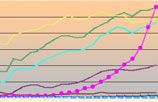Hope Ukraine peace deal succeeds despite all its weak nesses
By Op Rana (China Daily) Updated: 2015-02-16 08:35Fighting, however, has continued, with many people reported killed in exchange of fire even after the four leaders agreed to a ceasefire. Uncertainly and subterfuge continue in eastern Ukraine.
What started as a protest against former Ukrainian president Viktor Yanukovych for agreeing to a Russian bailout and keeping on hold a European Union association agreement soon transformed into a full-fledged revolt against his government, thanks to Western support to the protesters, and ultimately his ousting in February last year. As was expected, the United States, and its EU allies, jumped into the fray because it offered a golden opportunity to minimize Russia's influence and consolidate NATO's eastward march. By extending NATO's eastward reach, the US could achieve two goals: corner Russia immediately and build a military barrier to check China's growing influence in the region.
It is too early to say whether the US has succeeded in its designs. But it has been making things difficult for Putin both economically, because of the sanctions, and strategically. Making matters worse is the US' insistence on supplying weapons to Ukraine to crush the pro-Russia rebels and, by default, test Russia's military. And the price of all this political and strategic game has been borne by the Ukrainian people.
Amid this stark scenario, the Minsk agreement has indeed come as a boon for the battered and shattered people of Ukraine. But how can any agreement to end the Ukraine crisis, or for that matter most of the crises around the world, work without the United States being a party to it? Doesn't the US have a finger in every global and regional pie? Just think of the US' determination to arm Kiev to counter Russia and you will get an idea of what to expect from the Minsk agreement.
But despite the worst fears, the peace-loving people of the world hope peace returns to Ukraine.
The author is a senior editor with China Daily. oprana@hotmail.com











